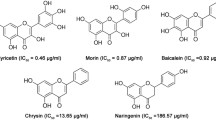Abstract
Staphylococcus aureus self-assembling α-hemolysin heptamer is an acute virulence factor that determines the severity of S. aureus infections. Hence, inhibiting the heptamer formation is of considerable interest. However, both natural and chemical inhibitors reported so far has difficulties related to toxicity, bioavailability, and solubility, which necessitate in identifying some alternatives. Hence, in this study, potential peptides for α-hemolysin inhibition was developed using in silico based approach. Haddock server was used to understand the residues involved in complex formation. Based on the key residues involved in the interaction, 20 peptides were designed and docked with the α-hemolysin monomer (Chain A). Further, the best scored Chain A-peptide complex was chosen and docked with Chain B to identify the ability of dimer formation in the presence of designed peptide. The stability of the Chain A–B dimer, Chain A-peptide and Chain A-peptide-Chain B complex was studied by performing molecular dynamic simulation over 3,000 ps. The peptide IYGSKANRQTDK was found to be binding efficiently with Chain A of α-hemolysin with highest binding energy and also revealed that the designed peptide disturbed the dimer formation, which provided useful information in developing promising lead for inhibiting α-hemolysin assembly in the future.





Similar content being viewed by others
References
Accelrys Software Inc (2003) Discovery studio modeling environment, Release 3.1. Accelrys Software Inc, San Diego
Bantel H, Sinha B, Domschke W, Peters G, Schulze-Osthoff K, Janicke RU (2001) alpha-Toxin is a mediator of Staphylococcus aureus-induced cell death and activates caspases via the intrinsic death pathway independently of death receptor signaling. J Cell Biol 155:637–648. doi:10.1083/jcb.200105081
Berendsen HJ, Postma J, Van Gunsteren W, Hermans J (1981) Interaction models for water in relation to protein hydration. Intermolecular forces. Springer, Amsterdam, pp 331–342
Craik DJ, Fairlie DP, Liras S, Price D (2013) The future of peptide-based drugs. Chem Biol Drug Des 81:136–147. doi:10.1111/cbdd.12055
de Vries SJ, van Dijk M, Bonvin AM (2010) The HADDOCK web server for data-driven biomolecular docking. Nat Protoc 5:883–897. doi:10.1038/nprot.2010.32
DeLano WL (2002) The PyMOL molecular graphics system
Deshmukh R, Purohit HJ (2012) Peptide scaffolds: flexible molecular structures with diverse therapeutic potentials. Int J Pept Res Ther 18:125–143
Gouaux E (1998) Alpha-Hemolysin from Staphylococcus aureus: an archetype of beta-barrel, channel-forming toxins. J Struct Biol 121:110–122. doi:10.1006/jsbi.1998.3959
Gray GS, Kehoe M (1984) Primary sequence of the alpha-toxin gene from Staphylococcus aureus wood 46. Infect Immun 46:615–618
Hess B, Kutzner C, Van Der Spoel D, Lindahl E (2008) GROMACS 4: algorithms for highly efficient, load-balanced, and scalable molecular simulation. J Chem Theory Comput 4:435–447
Jayasinghe L, Miles G, Bayley H (2006) Role of the amino latch of staphylococcal alpha-hemolysin in pore formation: a co-operative interaction between the N terminus and position 217. J Biol Chem 281:2195–2204. doi:10.1074/jbc.M510841200
Karplus M, McCammon JA (2002) Molecular dynamics simulations of biomolecules. Nat Struct Biol 9:646–652. doi:10.1038/nsb0902-646
Kelly CG, Lehner T (2007) Peptide inhibitors of Streptococcus mutans in the control of dental caries. Int J Pept Res Ther 13:517–523
Krissinel E, Henrick K (2007) Inference of macromolecular assemblies from crystalline state. J Mol Biol 372:774–797
Laskowski RA, Swindells MB (2011) LigPlot+: multiple ligand–protein interaction diagrams for drug discovery. J Chem Inf Model 51:2778–2786
Lipinski CA (2000) Drug-like properties and the causes of poor solubility and poor permeability. J Pharmacol Toxicol Methods 44:235–249
Maiti R, Van Domselaar GH, Zhang H, Wishart DS (2004) SuperPose: a simple server for sophisticated structural superposition. Nucleic Acids Res 32:W590–594. doi:10.1093/nar/gkh477
Maupetit J, Derreumaux P, Tuffery P (2010) A fast method for large-scale de novo peptide and miniprotein structure prediction. J Comput Chem 31:726–738. doi:10.1002/jcc.21365
Menestrina G, Serra MD, Prevost G (2001) Mode of action of beta-barrel pore-forming toxins of the staphylococcal alpha-hemolysin family. Toxicon 39:1661–1672
Menzies BE, Kernodle DS (1994) Site-directed mutagenesis of the alpha-toxin gene of Staphylococcus aureus: role of histidines in toxin activity in vitro and in a murine model. Infect Immun 62:1843–1847
Mueller M, Grauschopf U, Maier T, Glockshuber R, Ban N (2009) The structure of a cytolytic alpha-helical toxin pore reveals its assembly mechanism. Nature 459:726–730. doi:10.1038/nature08026
Pr Bjelkmar, Larsson P, Cuendet MA, Hess B, Lindahl E (2010) Implementation of the CHARMM force field in GROMACS: analysis of protein stability effects from correction maps, virtual interaction sites, and water models. J Chem Theory Comput 6:459–466
Song L, Hobaugh MR, Shustak C, Cheley S, Bayley H, Gouaux JE (1996) Structure of staphylococcal alpha-hemolysin, a heptameric transmembrane pore. Science 274:1859–1866
Tweten RK, Christianson KK, Iandolo JJ (1983) Transport and processing of staphylococcal alpha-toxin. J Bacteriol 156:524–528
Valeva A, Weisser A, Walker B, Kehoe M, Bayley H, Bhakdi S, Palmer M (1996) Molecular architecture of a toxin pore: a 15-residue sequence lines the transmembrane channel of staphylococcal alpha-toxin. EMBO J 15:1857–1864
Vandenesch F, Lina G, Henry T (2012) Staphylococcus aureus hemolysins, bi-component leukocidins, and cytolytic peptides: a redundant arsenal of membrane-damaging virulence factors? Front Cell infect Microbiol 2:12. doi:10.3389/fcimb.2012.00012
Vlieghe P, Lisowski V, Martinez J, Khrestchatisky M (2010) Synthetic therapeutic peptides: science and market. Drug Discov Today 15:40–56. doi:10.1016/j.drudis.2009.10.009
Yamashita K et al (2011) Crystal structure of the octameric pore of staphylococcal gamma-hemolysin reveals the beta-barrel pore formation mechanism by two components. Proc Natl Acad Sci USA 108:17314–17319. doi:10.1073/pnas.1110402108
Acknowledgments
Saravanan Vijayakumar is supported by the DBT-BINC senior research fellowship.
Author information
Authors and Affiliations
Corresponding author
Rights and permissions
About this article
Cite this article
Rani, N., Saravanan, V., Lakshmi, P.T.V. et al. Inhibition of Pore Formation by Blocking the Assembly of Staphylococcus aureus α-Hemolysin Through a Novel Peptide Inhibitor: an In Silco Approach. Int J Pept Res Ther 20, 575–583 (2014). https://doi.org/10.1007/s10989-014-9424-x
Accepted:
Published:
Issue Date:
DOI: https://doi.org/10.1007/s10989-014-9424-x




